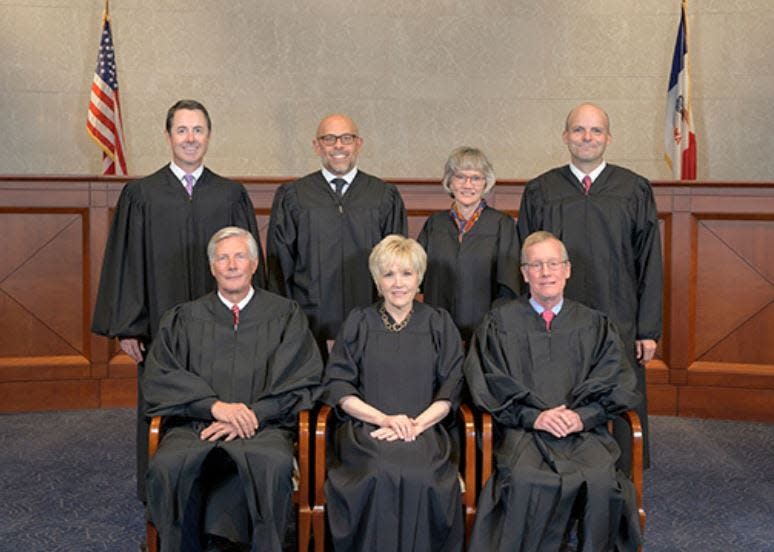Iowa Supreme Court's tie vote on 6-week abortion ban puts focus on Justice Dana Oxley
The Iowa Supreme Court's surprising tie vote that left the state's abortion rights intact suggests that even with its 7-0 majority of Republican appointees, the court could still pose a considerable obstacle to abortion restrictions, legal experts say.
And the lone justice who recused herself from the case could well provide the pivotal swing vote that would decide whether Iowa joins other conservative states in abolishing or significantly restricting abortion rights.
The court was asked to consider an appeal by Gov. Kim Reynolds, who sought to revive a state "fetal heartbeat" law that would ban most abortions after about the sixth week of pregnancy.
Reynolds lost her appeal on June 16, when the Supreme Court announced it was deadlocked 3-3, and the law would remain blocked.
But nonbinding advisory opinions that the justices filed explaining their reasoning suggest that despite its seven Republican appointees, the court could still prove to be an obstacle for harsher abortion laws, said Mary Ziegler, a University of California-Davis law professor and expert on the history of abortion legislation.

"South Carolina has a pretty conservative supreme court, and they reached a conclusion a six-week ban was unconstitutional. Oklahoma has a conservative supreme court," yet struck down two abortion restrictions this year, Ziegler said in an interview. "Some of the places we’ve seen state supreme court decisions come out a certain way are not where you would expect."
Much could hinge, she said, on Justice Dana Oxley, who recused herself because of her former law firm's involvement in the "fetal heartbeat" case. She has issued fewer opinions than the other justices that might shed light on her position.
"(Oxley) is going to have a lot of pressure from lots of different directions. But all of them will, really," Ziegler said.
The court's standard for future abortion laws remains unclear
Courts have developed multiple standards for evaluating the constitutionality of a law.
A law that impinges upon a core constitutional right, such as freedom of speech, is judged under the "strict scrutiny" standard, a high bar that few restrictive laws can clear.
Conversely, laws that do not intrude on protected rights or classifications of people are subject to "rational basis" review, a significantly easier standard that nearly every law will clear. In between is "intermediate scrutiny," used primarily in gender discrimination cases.
Before the 2022 Dobbs decision, the U.S. Supreme Court imposed another intermediate standard, known as "undue burden," on abortion restrictions. While recognizing the state's interest in protecting life, the court nonetheless held laws should be struck down if they created a "substantial obstacle" to someone seeking an abortion of a nonviable fetus.
Although the Dobbs decision struck down the undue burden standard on the federal level, the district judge who declined to revive Iowa's six-week ban held that the standard remains in effect in Iowa, based on several state Supreme Court decisions over the past eight years.
This month's split decision from the court shows at least three justices agree that the undue burden standard governs Iowa law — at least for now.
How did Iowa get the undue burden standard?
Regardless of whether the undue burden standard is correctly considered Iowa's current legal standard, Justice Christopher McDonald, writing arguments for why the injunction should be struck down, points out that the original adoption of that standard in Iowa was more incidental than intentional.
In a 2015 case between Planned Parenthood and the Iowa Board of Medicine, the court overturned state regulations limiting when and how doctors can prescribe abortion-inducing drugs.
At the time, the undue burden standard applied nationwide under the U.S. Supreme Court's 1992 Casey decision, and Justice David Wiggins wrote that the state "has conceded the Iowa Constitution provides a right to an abortion that is coextensive with the right available under the United States Constitution."
Accordingly, the 2015 court found the rules in question constituted an undue burden and rejected them.
In 2018, the court went further, finding that abortion was a "fundamental right" under the Iowa Constitution and that any restrictions would have to pass strict scrutiny.
In 2022, the court reversed itself, finding the 2018 decision was in error.
2015 ruling applying undue burden standard casts long shadow
But as in 2015, Justice Edward Mansfield, who wrote the plurality decision in 2022, declined to make a case for what the proper standard should be. Instead, he wrote that "For now, this means that the Casey undue burden test we applied in (2015) remains the governing standard."

Once again, the Iowa constitutional standard defaulted to the federal standard — which was nullified a week later when the Dobbs decision from the U.S. Supreme Court overturned both Casey and Roe v. Wade, the 1973 decision that had legalized abortion nationwide.
In this month's split decision, the three justices who favored keeping the injunction in place once again held that the undue burden standard is the prevailing law in Iowa, citing the 2015 decision.
The other three justices argued that, since the 2015 decision held only that Iowa's standard was "coextensive" with the federal standard, the Dobbs decision ending the undue burden standard on the federal level should have ended it in Iowa as well.
But because the dueling 3-3 opinions do not set any precedent, the legal status quo remains going forward.
David Cohen, a Drexel University law professor who studies and writes about abortion law, said the struggle to define Iowa's constitutional posture toward abortion is mirrored in other states around the country.
"There was some sense that the U.S. Supreme Court thought that it was making it easier by saying that there's no constitutional right, and we'll just leave it to the states," Cohen said. "But there's a lot of confusion in a lot of different states right now, about the law and the practicalities of implementing Dobbs."
For Iowa, the upshot is that despite multiple Supreme Court cases in the past decade dealing with challenges to abortion restrictions, there has never been a majority ruling adopting the undue burden standard on its own merits or laying out the legal arguments for why the Iowa Constitution should be read to guarantee that level of protection for abortions.
Even so, until a majority of the court rules otherwise, district courts likely will continue to treat undue burden as the governing legal standard.
How might the Iowa Supreme Court justices rule next time?
If the Iowa Legislature does pass a new abortion restriction, or even the same six-week limit, previous decisions provide a number of hints of how the justices might respond.
Three justices, McDonald, Matthew McDermott and David May, have made clear they would reject the undue burden standard in favor of a rational basis review — under which almost any abortion restriction would likely be found constitutional.
McDermott and McDonald argued for that result in a partial dissent in 2022, and May, who joined the court since that decision, signed on to both McDermott's and McDonald's opinions this month calling for Iowa's standard to be rational basis.
Conversely, Justice Thomas Waterman, who wrote for the three justices who voted on procedural grounds to keep in place the injunction blocking the "fetal heartbeat" law, spoke positively of the undue burden standard.
Quoting Mansfield from 2022, Waterman noted that “autonomy and dominion over one’s body go to the very heart of what it means to be free" and that “being a parent is a life-altering obligation that falls unevenly on women in our society,” even while recognizing "the state’s vital interest in protecting unborn life."

"The undue burden test balances the state’s interest in protecting unborn life and maternal health with a woman’s limited liberty interest in deciding whether to terminate an unwanted pregnancy," Waterman wrote, with Mansfield and Chief Justice Susan Christensen concurring.
Ziegler said it's a "reasonable reading" to interpret that language as saying Waterman, Mansfield and Christensen would support keeping the undue burden standard.
Related: Planned Parenthood to close some Iowa centers but increase capacity for rising abortions
"There was a lot of language in (Waterman's) opinion that Dobbs doesn’t change that," she said. "Whether undue burden is good or not, whether it squares with the Iowa constitutional law or not, is a question for the Iowa Supreme Court to review with fresh eyes. I do think that’s a possibility going forward."
Cohen also saw Waterman's language as suggesting support for the undue burden standard, but cautioned that it's hard to guess what will happen when the full court hears the next case.
"I think without the seventh justice on the case, it's just impossible to predict what the future is going to be," he said.
In future cases, all eyes are on Justice Dana Oxley
If, in fact, this month's ruling shows three justices in support of the undue burden standard and three for rational basis review, the deciding vote would come down to Justice Oxley.
Oxley, who was appointed in 2020, occupies a unique position on the court. A Des Moines Register analysis of the 2021-22 judicial term found that of all justices, Oxley wrote the fewest opinions but was most often in the majority, supporting the prevailing view in 96 of 105 cases.
In the 2022 case striking down the strict scrutiny standard for Iowa abortion cases, Oxley was one of three justices who did not write her own opinion. Instead, she joined in full with Mansfield's plurality opinion, rejecting strict scrutiny and keeping in place "for now" the undue burden test.
She did not join McDermott's partial dissent calling for the court to impose rational basis review.

Ziegler said the next case will bring a lot of attention not just on Oxley but on all the justices. Already, one prominent evangelical leader has called for the justices who voted to block the "fetal heartbeat" law to be removed from office.
"State supreme court justices have political accountability," Ziegler said, "and they’re charged with interpreting the law, and they face pressure from a lot of interest groups that often donate to campaigns. It's a new era for state supreme courts."
What laws might the Iowa Legislature pass?
Abortion is currently banned in most cases after the 20th week in Iowa. Reynolds and Republican legislators have made it clear they want to go further.
More: Iowa physicians worry relief from prospect of 6-week abortion ban will be short-lived
Any law passed with tighter restrictions will almost certainly be challenged in court, and such a lawsuit would inevitably come back before the Iowa Supreme Court.
"This is just going to be a continuing battle," Cohen said. "The clinics aren't going to stop in Iowa. People in Iowa aren't going to stop needing abortions. And the people who oppose abortion aren't going to stop trying to stop it."
The recent split decision suggests that, depending on where Oxley falls, the court might not be on board for a too-strict regime, Ziegler said. Waterman's comments about balancing the rights of the mother and the state suggest at least half the court believe the constitution should protect at least some access to abortion, she said.
"You can see what he sees the undue burden test as doing, which is fairness and balancing, averting the extremes," Ziegler said.
Without the procedural questions that complicated the recent split decision, the full court may finally confront the question of what protections the Iowa Constitution should guarantee for abortion rights, and whether the Iowa court should follow the example of Dobbs, or set out its own interpretation of what the Iowa Constitution requires.
"This may be some justices saying, the way for the Iowa constitution is a middle way," Ziegler said. "… Exactly what that looks like, what they mean by undue burden, we have to see elucidated. But I think that’s what the terms of the struggle are."
William Morris covers courts for the Des Moines Register. He can be contacted at [email protected], 715-573-8166 or on Twitter at @DMRMorris.
This article originally appeared on Des Moines Register: Iowa Supreme Court abortion ruling previews divide in future cases
